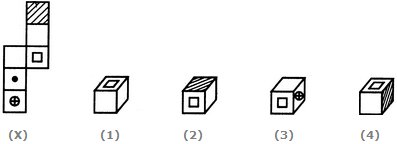Discussion
Home ‣ Non Verbal Reasoning ‣ Analogy See What Others Are Saying!
- Question
Select a suitable figure from the Answer Figures that would replace the question mark (?).
Problem Figures: Answer Figures: (A) (B) (C) (D) (1) (2) (3) (4) (5)
(A) (B) (C) (D) (1) (2) (3) (4) (5)
Options- A. 1
- B. 2
- C. 3
- D. 4
- E. 5
- Correct Answer
- 3
ExplanationThe figure rotates through 90 oACW. - 1. NEXA
Options- A. .
- B. .
- C. .
- D. . Discuss
- 2. Choose the correct water image of the figure from responses given below?
Options- A. 1
- B. 2
- C. 3
- D. 4 Discuss
- 3. Choose the alternatives which is closely resembles the water image of the given combination.
Options- A. (a)
- B. (b)
- C. (c)
- D. (d) Discuss
- 4. Choose the alternatives which is closely resembles the water image of the given combination.
Options- A. (a)
- B. (b)
- C. (c)
- D. (d) Discuss
- 5. Choose the alternatives which is closely resembles the water image of the given combination.
Options- A. (a)
- B. (b)
- C. (c)
- D. (d) Discuss
- 6. Select a suitable figure from the Answer Figures that would replace the question mark (?).
Problem Figures: Answer Figures:
 (A) (B) (C) (D) (1) (2) (3) (4) (5)
(A) (B) (C) (D) (1) (2) (3) (4) (5)
Options- A. 1
- B. 2
- C. 3
- D. 4
- E. 5 Discuss
- 7. Select a figure from amongst the Answer Figures which will continue the same series as established by the five Problem Figures.
Problem Figures: Answer Figures:
 (A) (B) (C) (D) (E) (1) (2) (3) (4) (5)
(A) (B) (C) (D) (E) (1) (2) (3) (4) (5)
Options- A. 1
- B. 2
- C. 3
- D. 4
- E. 5 Discuss
- 8. Group the given figures into three classes using each figure only once.

Options- A. 1,4,7 ; 3,6,9 ; 2,5,8
- B. 1,6,9 ; 2,4,7 ; 3,5,8
- C. 1,4,7 ; 2,6,9 ; 3,5,8
- D. 1,5,7 ; 2,6,9 ; 3,4,8 Discuss
- 9. Select a figure from amongst the Answer Figures which will continue the same series as established by the five Problem Figures.
Problem Figures: Answer Figures:
 (A) (B) (C) (D) (E) (1) (2) (3) (4) (5)
(A) (B) (C) (D) (E) (1) (2) (3) (4) (5)
Options- A. 1
- B. 2
- C. 3
- D. 4
- E. 5 Discuss
- 10. Choose the box that is similar to the box formed from the given sheet of paper (X).

Options- A. 1 only
- B. 2 and 3 only
- C. 1 and 3 only
- D. 1, 2 and 4 only Discuss
More questions
Correct Answer: .
Explanation:
Answer A
Correct Answer: 2
Explanation:
As per the given above question figure ,
Figure ( 2 ) of the answer figures is exactly the water image of the given original image . Thus , Given image will become opposite in water across the given line.So , option B is correct figure .
Correct Answer: (b)
Explanation:
Upper part will go down in opposite direction in water image.
Correct Answer: (d)
Explanation:
Upper part will go down in opposite direction in water image.
Correct Answer: (b)
Explanation:
Upper part will go down in opposite direction in water image.
Correct Answer: 3
Explanation:
 the elements reaching the upper-left and the lower-right positions rotate 90
oACW; the elements reaching the upper-right and lower-left positions rotate 90
oCW; the central element rotates 90
oACW and gets laterally inverted.
the elements reaching the upper-left and the lower-right positions rotate 90
oACW; the elements reaching the upper-right and lower-left positions rotate 90
oCW; the central element rotates 90
oACW and gets laterally inverted.
Correct Answer: 3
Explanation:
Correct Answer: 1,4,7 ; 2,6,9 ; 3,5,8
Explanation:
2, 6, 9 have similar designs (three of the corners of the main figure are shaded black and there is a pattern formed around a '+' sign at the centre of the figure).
1, 4, 7 have similar designs (there are four small circles at(the corners of the main figure and there is a wheel shaped element at the centre of the figure).
Correct Answer: 5
Explanation:
Correct Answer: 1 and 3 only
Explanation:
Comments
There are no comments.Programming
Copyright ©CuriousTab. All rights reserved.
